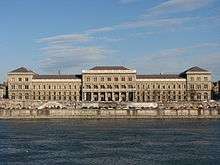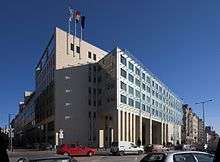Corvinus University of Budapest
| Budapesti Corvinus Egyetem[1] | |
 | |
| Motto |
Scientia mea - Adiutor meus (My knowledge is my helper) |
|---|---|
| Type | Public university |
| Established | 1920 |
| Rector | Prof. Dr. András Lánczi |
Administrative staff | 867 |
| Students | 14,500 |
| Location | Budapest, Hungary |
| Campus | Urban |
| Affiliations | Professional organisations: AACSB, AFANet, APSA, DRC, EAPAA, EUA, ECLAS, EFMD, ESA, IAU, ICA, IFLA, NISPA, PRME. Professional networks: ECA, CEEMAN, CEMS, EDAMBA, FFNet, LE NOTRE, MIRC, PIM |
| Website |
www |
Corvinus University of Budapest (Hungarian: Budapesti Corvinus Egyetem) is a university in Budapest, Hungary. Corvinus University of Budapest defines itself as a research university oriented towards education. The university admits 14,000 students, offering educational programmes in agricultural sciences, business administration, economics, and social sciences.
Corvinus University accepts students at six faculties and offer courses leading to degrees at the bachelor, master and doctoral level in specialisations taught in Hungarian, English, French or German.
The academic rankings of the universities’ prestige, professional and social acceptability are measured regularly. Year by year, the university is among the best institutions on various national and international rankings. It was listed in the top 50 in the Financial Times European Masters in Management rankings,[2] and was the first Hungarian university mentioned among the best in the area of agriculture.
Ministers of finance, chairmen of the National Bank of Hungary and prime ministers studied at Corvinus.
History
In 1846, József Industrial School opened its gates with departments for economics and trade for upper grade students. The immediate forerunner of the Corvinus University of Budapest, the Faculty of Economics of the Royal Hungarian University, was established in 1920. The faculty was an independent organization that was granted the same status as faculties of other universities.[3]
In 1934, the faculty was merged with other institutions including the University of Technology to form the Hungarian Royal Palatine Joseph University of Technology and Economics.[4] Modern economist training began in 1948, when the Hungarian University of Economics was established as a separate universitas.[5] Since then, the institution has undergone multiple name changes. In 1953 it was renamed Karl Marx University of Economic Sciences.[6] In 1990 the political system changed in Hungary. After 43 years democratic and free parliamentary elections were held. Following that the name of the university was changed to the University of Economics of Budapest.
In 2000, with the integration of the College of Public Administration, the institution was named Budapest University of Economic Sciences and Public Administration (BUESPA). The College of Public Administration was founded in 1977.[7]
In 2003, the three faculties of the former University of Horticulture (then part of the Szent István University) were integrated into the BUESPA. The first predecessor of the horticulture faculties, the School for practical Gardening (1853 - 1860) was the first institution of horticultural professional training in Hungary. The school was founded and managed by the horticultural scholar and publicist Dr Ferenc Entz (1805 - 1877), who was also a corresponding member of the Hungarian Academy of Sciences (HAS).[8] In 1939 an independent Royal Horticultural Academy was launched. It included three departments: agriculture, horticulture and landscape architecture. The latter was one of a kind in Hungary at the time.
In 2004, the university received its present name.[9] The name the Corvinus University of Budapest refers to the name of Corvinae (codices). Bibliotheca Corviniana was one of the most renowned libraries of the Renaissance world, established by the king Matthias Corvinus of Hungary.
The Faculty of Public Administration was appended[10] to the newly formed National University of Public Service[11] January 1, 2012.
From 2013 Corvinus University of Budapest offered a Summer School program.[12]
Faculties
As of 2016, the university has three faculties:
- Faculty of Business Administration
- Faculty of Economics
- Faculty of Social Sciences
Setting and architecture

The university is in an urban setting. The faculties operate in multiple buildings that stand in the city centre of Budapest.
The university's main building — now part of the UNESCO Heritage Site[13] — is located in Pest on the left bank of the Danube, next to the Grand Market Hall and facing the Budapest University of Technology and Economics on the river's other bank. The main building was planned by Miklós Ybl as the Main Customs Office in Neo-Renaissance style. It was finished in 1874. The building was called "Vámház" (Customs House) and "Fővámpalota" (Chief Customs Palace). This is also the name of the nearby avenue. The building was connected to ports of the Danube by four tunnels. It had a railroad connection. During WW2 the Hungarian, German and Soviet troops used the building as a military base. The Customs House suffered serious damage during the war. In 1948 it became the main building of the University of Economics. It underwent major renovations in 1950 and later in 1989-1990.
Much of the education of the business faculties (Faculty of Business Administration, Economics, Social Sciences) takes place in the main building. This is the location of the rector's offices as well.

The new Közraktár Street building of the university was completed in 2007. It offers 50,000 m2 of floorspace, which includes an office building and education areas. The building has community areas, and hosts the 450-seat central library of the university which contains 100,000 books and journals.[13][14]
The horticulture faculties are located on Villanyi Road on the Buda side of Budapest. A highlight of the Buda campus is the 7.5-acre (30,000 m2) Buda Arboretum,[15] which includes trees of 1,640 species and hundreds of species of other plants. The arboretum is used as a demonstration garden in dendrology classes.
Student life
Seven colleges for advanced studies are connected to the university. These are student groups that offer their own body of extracurricular coursework and often provide accommodation for their members as well.
- EVK Szakkollégium
- Society of Young Autonomous Economists (FAKT)
- Heller Farkas Szakkollégium
- Rajk László College for Advanced Studies
- Széchenyi István College for Advanced Studies
- Rerrich Béla Tájépítészeti Szakkollégium
- College for Advanced Studies in Social Theory (Társadalomelméleti Kollégium, TEK)
Notable alumni
- Ancsin László – wrestling champion
- Bajnai Gordon – former Prime Minister of Hungary
- Betlen János – journalist
- Bokros Lajos – former Minister of Finance, Chairman of Budapest Stock Exchange
- Csaba László – economics professor, member of the Hungarian Academy of Sciences
- Chikán Attila – former Minister of Economy
- Czene Attila – Olympic Champion swimmer
- Beke-Martos Gábor – CEO of Hungarian subsidiary of Siemens
- Ferjancsik Domonkos – swordsman
- Herczeg Zoltán – fashion designer
- Járai Zsigmond – former Minister of Finance, Chairman of the National Bank of Hungary
- Kondor Katalin – journalist
- Kornai János – economist, member of the Hungarian Academy of Sciences
- Kovács Ágnes – Olympic Champion swimmer
- Kovács Ákos – singer, one of the best-selling artists in Hungary
- Kupa Mihály – former Minister of Finance
- László Csaba – former Minister of Finance
- Matolcsy György – former Minister of Economy, current Chairman of the National Bank of Hungary
- Medgyessy Péter – former Prime Minister and Minister of Finance
- Németh Miklós – former Prime Minister
- Öveges József – professor of Physics
- Peter Darvas – economist
- Simor András – former Chairman of the National Bank of Hungary
- Surányi György – former Chairman of the National Bank of Hungary
- Szűrös Mátyás – politician, former acting President of the Republic
- Varga Mihály – former Minister of Finance, current Minister of National Economy
- Veres János – former Minister of Finance
References
- ↑ Study in Hungary: Corvinus University of Budapest
- ↑ Financial Times: FT.com / Business Education / Masters in management
- ↑ 1920. évi XXXI. törvénycikk - a budapesti kir. magyar tudományegyetemi közgazdaságtudományi kar felállításáról és ideiglenes szervezetéről. http://www.1000ev.hu/index.php?a=3¶m=7446
- ↑ 1934. évi X. törvénycikk: Magyar Királyi József Nádor Műszaki és Gazdaságtudományi Egyetem. http://www.1000ev.hu/index.php?a=3¶m=7953
- ↑ Küzdelem egy önálló közgazdasági egyetemért. Rosta Miklós, Magyar Tudomány, 2001/8. http://www.matud.iif.hu/01aug/rosta.html
- ↑ A Közgazdászképzés története. Budapesti Corvinus Egyetem. http://www.uni-corvinus.hu/index.php?id=p100017
- ↑ 30 éves jubileum. Budapesti Corvinus Egyetem, Közigazgatástudományi kar. http://www.uni-corvinus.hu/index.php?id=18350
- ↑ Kertészeti felsőoktatás Magyarországon. Az első 150 év. Budapesti Corvinus Egyetem. http://kerteszettudomany.uni-corvinus.hu/index.php?id=p300113
- ↑ A Budapesti Corvinus Egyetem Története. Budapesti Corvinus Egyetem
- ↑ [2011. évi XXXVI. törvény http://www.complex.hu/jr/gen/hjegy_doc.cgi?docid=A1100036.TV]
- ↑ [National University of Public Service http://www.uni-nke.hu]
- ↑ Corvinus Summer School. http://www.uni-corvinus.hu/summerschool
- 1 2 Új épület a Corvinus Egyetemnek. Építészfórum, 2007-09-13. http://epiteszforum.hu/node/6985
- ↑ Budapesti Corvinus Egyetem, új épület, Budapest. Épülettár. http://www.epulettar.hu/modules/epulet/details.aspx?nid=420
- ↑ Budai Arborétum. http://budaiarboretum.uni-corvinus.hu/
External links
- Official website
- Corvinus Summer School, official website
- MBA Programme Website of Corvinus University, School of Management
- History of Corvinus University in English
- Scientific Journal of the Faculty of Economics
- Corvinus University in the Financial Times rankings
Coordinates: 47°29′10″N 19°3′29″E / 47.48611°N 19.05806°E